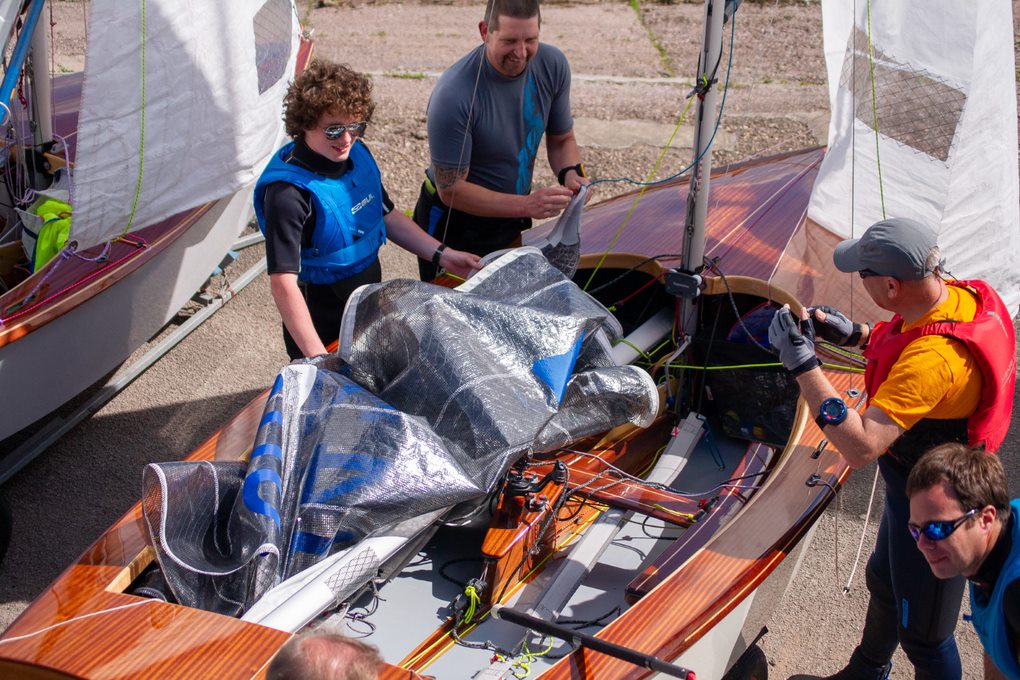Rigging tips for club boats
The Vision and Feva race sails are Mylar laminate – two layers of clear polyester film glued under heat and pressure to a reinforcing mesh of some exotic yarn. If these sails are creased or folded then they get holes and cracks in them, which is not fast. Leaving them hoisted and flogging will also damage them. Unroll these sails and carefully flake down into the boat avoiding any folds or creases before hoisting, After sailing, roll carefully avoiding creases. Rolling the sail up on the gunwhale (side deck) is probably easiest, best with two people. The battens should be parallel with the roll.
Covers
On arrival – all boats:
Undo all the straps, undo the halyard holding up the cover and secure it to a shroud, then fold the bow flaps back behind the mast, and roll or fold the cover towards the transom.
Unlock the Feva padlocks – leave the padlocks open so that you can lock the boat up without the keys when you put the boat away.
Lift the cover off the transom and put it down. Picking it up the same way round after sailing, putting it on the transom and rolling it forward saves time trying to work out which end is which.
Putting away – all boats:
Place cover on transom and unroll forwards.
On the Fevas, poke the plate up through dagger board case, put the plate with a slot over the bar, and put the padlock though hole in the bar.
On the Fevas, lie the boom with the gooseneck resting on the jib halyard cleat and the back of the boom on the inspection hatch so that the cover forms a tent to stop rain ponding up on the cover. Tension mainsheet and kicker to keep it there.
Attach the halyard to the loop on the top of the cover and tension it to pull the cover up so that water will run off – on the Laser 2000 the halyard goes on the D-ring on the mast collar to pull the mast collar up the mast for the same reason.
Tie the mast collar as high up the mast as you can – tying it at deck level almost guarantees that rain will collect in the cover.
Now attach the straps – they are all long enough to pass under the ends of the boats to save grovelling in the dirt – you just have to lift the bow slightly for the front straps.
Tighten the straps – tight enough to get the cover taut so that rainwater runs off, but not hard enough to break the buckles!
Replace the steel cable – just one turn around the masts on all the Fevas and the Vision. There is thin rope and cable to tie the Vision to the tree.

Halyards & spinnaker lines
While rigging and derigging, tie off the halyards to stop them blowing out of reach – this also prevents the end of the halyard shooting up the mast out of reach when you inadvertenly pull on the other end.
If the spinnaker or jib halyards go up the mast on the Fevas, please retreive them before leaving the boat – either by capsizing the boat in the shallows, or wheeling the boat up the the clubhouse balcony.
When hoisting the main sail, remove the halyard from the clamcleat on the Vision, otherwise friction will burn a groove in the aluminium teeth of the cleat, and the sail will fall down.
Friction from pulling halyards over any part of the hull or deck moulding will burn unsightly grooves in polyethelyne or fibreglass. Stand further back and pull directly from the pulley on the mast.
Check that the halyards are not twisted before you leave the boat. When you’ve removed the spinnaker, tie the end of the spinnaker halyard around the mast just below the gooseneck using half hitches, and tie the spinnaker downhaul that runs through the chute to the tack line that emerges from the end of the pole using a double sheetbend.
Avoiding unnecessary damage
Rotomoulded polyethelyne boats are not indestructible – we have them because they are significantly cheaper than fibreglass and bounce better. Dents and scratches on the Fevas and Vision would have necessitated a professional repair to a fibreglass boat. Nevertheless, you can lengthen the active lives of all our boats by:
- Avoiding collisions- keep a good lookout and sail by the rules
- Float the boat off and on to the trolley – be gentle!
- On shore, balance the boat on the trolley by ensuring the bow is right forward.
- Do not lift the front of the trolley too high, to avoid dragging the transom on the ground.
- Always hoist the main at the last moment before going afloat, and as soon as you are ashore, to stop the boat being blown over by gusts.
Happy sailing!